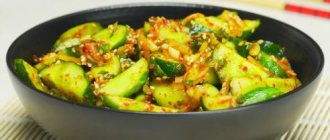How to prepare soy sauce
Initially, fish dishes were prepared with the addition of soybeans. Over time, they learned to make sauce from them. It was quite thick and expensive, so they began to add water to it in order to save money.
According to the writings of the scribes of Ancient China, the best sauce is prepared by completely boiling the beans with the addition of the same amount of barley or wheat. At the end of cooking, the whole thing is filled with salt and water. Then the mass should be left to ferment for three to four months. Wheat or barley is added due to the presence of the koji fungus in these grains, which causes the wort to ferment.
Due to the relative simplicity of the sauce preparation process, you can try making it yourself. How is the sauce prepared? Simple enough.
For this you will need:
- soybean – 100 g;
- broth - 2 tbsp. l.;
- salt - according to preference;
- butter – 2 tbsp. l.;
- wheat flour – 2 tbsp. l.
The cooking process looks like this:
- Boil the beans until fully cooked and grind the mixture through a sieve or grind to puree in a blender.
- Add broth and butter, salt and flour to the mixture.
- Mix thoroughly and place on the stove. Bring to a boil and stir constantly. The sauce is ready.
What is soy sauce made from?
Soybeans
Authentic Asian cuisine is famous for its delicious sauces. Soy is characterized by a neutral taste called umami, which is responsible for the naturally occurring monosodium glutamate. The preparation of traditional soy sauces involves the fermentation of a mixture of beans and grains of moldy mushrooms. Previously, this was exposed to the sun in huge vats to allow the wort to ferment.
The total cooking time lasts 3 days. The smells and texture are not the same as traditional ones, but they also have a much longer shelf life, so the amount produced is different.
How is soy sauce made? Traditional production is divided into several stages:
- soaking and boiling the beans until tender with frying and pounding the wheat;
- combining beans and grains with sowing spores of a certain type of fungus;
- going through the fermentation process by soaking beans and grains with saline solution;
- pressing to separate the sauce from the waste;
- pasteurization to remove mold and yeast;
- filtering for product sales.
Often, soy sauce becomes the basis for beef or poultry marinade. A real storehouse of amino acids and antioxidants. All components prevent the occurrence of serious diseases.
Wings in honey and soy marinade
Below is a quick and simple recipe that will win you over from the first serving. Wings in honey soy sauce are a great addition to any side dish.
To implement this recipe you will need:
- chicken wings – 1 kg;
- “chicken” spices - to taste;
- bee honey - 3 tbsp. l.;
- tomato paste or ketchup – 2 tbsp. l.;
- soy sauce – 5 tbsp. l.;
- vegetable oil – 3 tbsp. l.;
- garlic – 3 cloves.
The cooking algorithm is simple:
- We rinse the wings well under running water and leave to dry.
- For the marinade, mix spices, sauce, ketchup, oil, garlic and honey.
- Place the wings in a deep bowl and pour the prepared sauce over them. Mix with your hands to distribute the marinade evenly. Leave to soak for 3 – 4 hours. The longer the wings are infused in the marinade with soy sauce, the richer and spicier the finished dish will be.
- Bring the oven temperature to 210 degrees. Place the wings on a greased baking sheet.
- We bake the preparations in the oven for 35 – 45 minutes.
Chicken in soy sauce in a frying pan
The chicken according to this recipe turns out very juicy, with a delicate taste and aroma.
To perform it you will need:
- chicken (or parts thereof) – 1 kg;
- salt and ground black pepper - optional;
- onions - 2 medium onions;
- oil (preferably from olives) – 1.5 tbsp. l.;
- soy sauce – 120 ml;
- herbs and other seasonings - to taste.
Let's prepare it like this:
- Wash the chicken parts and remove the skin.
- Chop the onion into half rings and combine in a separate container with the prepared chicken. Mix everything thoroughly.
- Preparing the filling. Mix oil, soy sauce, pepper and available chicken seasonings. Mix. You need to be careful about the amount of salt as soy sauce is very salty.
- Pour part of the marinade over the chicken, mix with your hands and leave to soak for 2 – 6 hours. You can leave the preparations from evening to morning.
- Cook the chicken in a deep frying pan. Place marinated chicken and onions on the hot bottom. Fry the meat pieces on different sides until golden brown.
- Add the rest of the marinade, cover with a lid and simmer for half an hour. You can stir occasionally. Chicken in soy sauce in a frying pan is ready.
Whole chicken in soy sauce in the oven is prepared according to the same recipe.
Composition of soy sauce
Composition of soy sauce
The number of macro- and microelements with amino acids is simply off the charts. The product is considered a real boon for vegetarians. It has long been known for its usefulness, which is why it is often used in cooking. Soy sauce, the composition of which includes vitamins and beneficial elements, is characterized by nutritional value:
- 0.6 g proteins;
- 6.6 g carbohydrates;
- 6.6 g mono- and disaccharides;
- 5.6 g of ash.
The calorie content per 100 g of product is 50-60 kcal, so the product is allowed during a diet or for those who are overweight. Excessive consumption threatens salt deposition, so it is important to monitor normal consumption.
To select the right product, you need to study the composition and calorie content. It is low in calories and lacks flavorings. The color is light brownish, and the amount of protein composition is from 8% with soybeans, wheat, salt, sugar, spices.
A glass bottle is a direct indication that the product is natural. There is no need to save when purchasing, since any violation of storage technology will cause serious illnesses.
The usefulness is obvious; it can easily become a substitute for salt and other seasonings. Now the dish is characterized not only by its deliciousness, but also by its usefulness. Ketchups and mayonnaise can be removed from the diet. But uncontrolled use can cause allergies.
Composition of classic soy sauce
Classic Sen Soy sauce is made by fermenting soybeans. Precipitation may occur. The product is made without dyes or flavors. Storage is provided at temperatures from 1 to 25 degrees, and the period of use is indicated on the packaging and is equal to 12 months.
Sen Soy classic sauce has a calorie content of 58 kcal. The required components of the product are water, soybeans, wheat, salt, sugar. Consumption of the product stabilizes blood circulation and prevents the occurrence of serious heart diseases. Blood vessels are strengthened, headaches and insomnia disappear, sprains and muscle spasms disappear.
What is soy sauce made from in Russia?
The process of making soy sauce
Russia has long been interested in this product and decided to start preparing it. To preserve the natural taste, a certain number of components are monitored and a number of rules are used:
- Ingredients. The natural product contains soybeans, wheat, salt, and water. The beans are soaked and dried, and the wheat is ground to speed up fermentation.
- Cooking process. Use of Kikkoman mushroom involved in fermentation. Enough 3 days and the base of the sauce will be ready.
- Fermentation and fermentation of moromi. Place the shoyu koji in a tank and mix it with the brine solution. Over time, the mixture acquires a unique taste, aroma, and color.
- Push-ups. After pressing, this sauce is called raw soy sauce. Standing for 3-4 days produces a purified product.
- Spill. Pouring is carried out automatically. Each batch is quality tested to ensure the requested standards. Thanks to a strict control system, the consumer receives a purified and healthy product.
When purchasing soy sauce, pay attention to the container for storing it. If it is glass, then you can safely buy the product. Otherwise, you have a low-quality mixture or a surrogate on which the manufacturer saved. Salty taste is one of the signs of the right choice.
Pork recipe
Below is a good option for a dish that can diversify a boring home menu. The meat turns out moderately juicy and fatty. Soy sauce gives it sophistication and subtle taste.
For cooking you will need:
- pork (preferably neck) – 1 kg;
- dried seasonings - 1 tsp;
- soy sauce – 200 ml;
- sesame – 2.5 tsp;
- white onion – 4 pcs.;
- vegetable oil (for frying);
- garlic – 7 – 8 teeth;
- water – half a glass;
- starch – 1.5 tsp.
Step by step process:
- Wash and dry the meat with paper towels, cut into small pieces.
- Place the pork in a deep bowl and pour in soy sauce. Stir and leave to marinate in the refrigerator for half an hour.
- We do not cut the onion into thin rings, but the garlic, on the contrary, into thin slices. It is not recommended to crush or grate it.
- Heat vegetable oil in a hot frying pan. Place the pork in it and pour in the marinade in which it was soaked. Cook for 6 – 7 minutes covered. Turn the meat periodically.
- Add onion and garlic. Simmer for another 6 minutes.
- Add starch to a glass of water and stir. Pour water into the pan, add sesame seeds and herbs. Mix the mixture thoroughly and simmer the meat for about half an hour over low heat.
Pork in soy sauce will be ready as soon as all the liquid is absorbed and the meat becomes soft and juicy.
Shrimp fried with garlic and soy sauce
An exotic and incredibly tasty dish will not leave anyone indifferent.
For cooking you will need:
- shrimp (preferably king) – 0.5 kg;
- oil (preferably olive);
- soy sauce – 260 ml;
- parsley (fresh);
- lemon – 1 pc.;
- garlic - 2 teeth.
Cooking process:
- Wash and dry the shrimp.
- Place them in a hot frying pan greased with olive oil and garlic.
- Add soy sauce and fry, stirring constantly, for 5 - 7 minutes.
- Place the prepared seafood on a plate and pour over lemon juice. Decorate with parsley.
Marinated fish baked in foil
Any white or red fish will work for this recipe.
During the cooking process you will need the following products:
- fish steak – 1 kg;
- bay leaf – 2 pcs.;
- regular onion - 1 pc.;
- pepper (peas) – 5 pcs.;
- sunflower oil – 6 tbsp. l.;
- salt and, if desired, a mixture of peppers;
- soy sauce – 70 ml;
- garlic - 3 teeth.
Cooking process:
- Clean and rinse the fish steak. Place on greased foil. Drizzle each piece of fish with sunflower oil on top - this will make it more juicy.
- Sprinkle the fish with a mixture of peppers and salt to taste.
- Fry the onion in a frying pan until golden brown. Place it on top of the fish preparations.
- Prepare the sauce. Crush the garlic cloves or cut into cubes. Combine with a mixture of peppers and add soy sauce.
- Pour the sauce over each steak. Place bay leaves and pepper on top and cover with a large piece of foil.
- Bake in a preheated oven for 35 - 40 minutes at 210 degrees.
Beef in soy sauce
Below is a step-by-step recipe according to which the beef is cooked in half an hour, but always turns out soft and melts in your mouth. Due to the short cooking time, the meat retains all the beneficial substances.
To prepare you will need:
- beef – 1 kg;
- garlic – 4 teeth;
- white onion – 2 pcs.;
- soy sauce – 200 ml;
- red hot pepper - to taste.
Cooking process:
- Cut the beef into thin strips. Make sure that the cut runs along the grain. The thinner the pieces, the faster the dish will cook.
- Place the beef in a deep bowl and pour soy sauce over it. Leave to marinate in a cool place for 4 – 5 hours. Or better yet, for the whole night.
- Cut the onion into cubes and fry until transparent. For a spicier dish, you can add finely chopped spicy pod at this stage.
- Add the beef to the onions and peppers, mix and simmer over high heat for 20 - 25 minutes, stirring occasionally. If necessary, add water.
- Simmer for another 15 - 20 minutes, after which the beef in soy sauce will be ready.
Types of soy sauce
Light soy sauce
Few people know that there are many recipes for its preparation, and each of them includes a complex fermentation process. Its type depends on the exposure periods:
- Light. It takes a little time to prepare. It is characterized by a light brown color and a pleasant aroma; it serves as an excellent addition to any dish.
- Dark. It is characterized by long aging and a fermentation period of about a year. The thick consistency has a pungent odor and is recommended for marinating meat or fish.
Store-bought ones are noticeably different from home-made ones, but the latter are higher in terms of usefulness.
Salad with soy sauce dressing
A unique recipe for those who maintain a slim figure.
To implement it you will need:
- Beijing - 200 g;
- ground pepper – 1 tsp;
- soy sauce – 5 tbsp. l.;
- cucumber – 2 – 3 pcs.;
- oil (preferably olive) – 2 tbsp. l.
Cooking process:
- We chop the cabbage and mash it a little with our hands right in the salad bowl.
- Three cucumbers on a Korean carrot grater.
- Season the vegetables with soy sauce.
- Add pepper and olive oil to the salad.
This salad and shrimp fried with garlic and soy sauce will complement each other perfectly.
Many dietary salads are prepared using soy sauce. It contains almost no calories and can be an equivalent replacement for salt.
Rating TOP 9 soy sauces
After evaluating the characteristics of all soy sauces from different manufacturers, I compiled a ranking of the best products. The top 10 best additions to the main dish, in my opinion, should look like this:
- Sen Soy Classic;
- Kikkoman;
- Bamboo Stalk Soy classic;
- Heinz original taste;
- Heinz classic;
- Sen Soy classic premium;
- Mivimex with pepper and garlic;
- CHIN-SU;
- SanBonsai Japanese.
Let's take a closer look at each product.
Sen Soy Classic
This product is obtained by natural fermentation of soybeans. To achieve such a rich consistency and unique taste, manufacturers subject the additive to longer aging. There are no artificial colors or preservatives in the composition.
The product is almost universal in use. It is suitable for most meat, vegetable dishes, and poultry. Soy sauce contains vitamin C and antioxidants. Its consumption in food improves blood circulation, prevents the occurrence of cardiovascular diseases, and prevents headaches and insomnia. After opening the bottle, it is recommended to store the product in the refrigerator.
| Purpose | For meat, poultry, vegetables |
| Volume, ml | 250 |
| Package | Glass bottle |
Price
from 50 to 56 rub.
- inexpensive;
- nice smell;
- good taste;
- natural fermentation.
- none.
I buy this soy sauce regularly. I marinate chicken in it and use it as a seasoning for fish. It turns out very tasty. I think there is excellent value for money here.
Expert opinion
Yulia Dukhanina
Ask a Question
Along with its benefits, soy sauce can also cause harm. For example, it can provoke salt deposition, but this only happens with excessive consumption of the product.
Review available on video
Sen Soy Classic
Kikkoman
Due to the special preparation technology, this soy sauce has a significantly reduced salt content. Thanks to this, the product is suitable for people who cannot eat a lot of salt for medical reasons.
A few drops are enough to fully reveal the taste of food. It can be used to season any product: from meat to rice. In Japanese and Korean dishes it will be the finishing touch. Soy sauce has a subtle aroma and slightly spicy taste.
| Purpose | For meat, poultry, fish, salad, vegetables, seafood, rice |
| Volume, ml | 150 |
| Package | Glass bottle |
Price
from 252 to 255 rub.
- convenient dispenser;
- high quality;
- fragrant;
- price-quality ratio.
- Expensive.
Great product. A little expensive, but I always try to buy it at a promotional price. I add it to various dishes. For sushi and rolls it is incomparable. There is nothing superfluous in the composition, which is also important.
A short overview can be seen in the video
Kikkoman
Bamboo Stalk Soy classic
Soy sauce can be used not only in traditional oriental cuisine, but also to enhance the taste of any meat and vegetable products. The low-calorie product contains useful components: vitamin B, zinc, amino acids.
Thanks to the choline contained in the product, the body fights migraines, arthritis, arthrosis, sclerosis, and cancer. This soy sauce has a pleasant, rich taste that can be combined with any dish.
| Purpose | For meat, vegetables |
| Volume, ml | 280 |
| Package | Plastic bottle |
Price
from 46 to 56 rub.
- delicious;
- cheap;
- fragrant.
- too salty.
I bought it as an additive for sushi. Very tasty, aromatic. Salty, but my family and I like it this way.
Expert opinion
Yulia Dukhanina
Ask a Question
Proper use of soy sauce in dishes allows you to fully reveal the taste of each product, emphasize it advantageously, and focus on a specific ingredient.
Bamboo Stalk Soy classic
Heinz original taste
The product has an original spicy taste. It is characterized by high quality and is suitable for any dish: meat, poultry, salad, vegetables and seafood. After opening the package, it is recommended to store it in the refrigerator. The product is good for up to 30 months.
| Purpose | For meat, pizza, salad, vegetables, seafood |
| Volume, ml | 150 |
| Package | Glass bottle |
Price
from 133 to 135 rub.
- budget;
- glass packaging;
- a good addition to any dish.
- sweet.
Excellent soy sauce, I like its unusual sweet taste. I season almost all my dishes with it. I already forgot the last time I bought some other sauce.
Review available on video
Heinz original taste
Heinz classic
A special feature of this product is the absence of preservatives and GMOs. It goes well with many dishes: meat, poultry, fish, salads, seafood. Ideal for rolls. The sauce has a shelf life of two years.
| Purpose | For meat, poultry, fish, salad, vegetables, seafood |
| Volume, ml | 150 |
| Package | Glass bottle |
Price
from 133 to 135 rub.
- delicious;
- suitable for sushi, rolls;
- inexpensive.
- very salty.
This sauce has an interesting, unusual aftertaste. The product is quite salty, which must be taken into account when preparing dishes. For example, we simply replace salt with this sauce. Perfect for preparing meat marinade. The taste is reminiscent of real, natural soy sauce, although for natural it is too cheap.
Heinz classic
Sen Soy classic premium
The sauce is prepared by natural fermentation of soybeans. The product goes well with seafood. There are no artificial colors or preservatives in the composition. The design of the glass soy sauce bottle is eye-catching. It is made in Japanese style.
| Purpose | For seafood |
| Volume, ml | 220 |
| Package | Glass bottle |
Price
from 74 to 75 rub.
- convenient packaging;
- rich taste;
- inexpensive;
- good composition.
- No.
The composition of this soy sauce is pleasing; there is nothing superfluous in it. For fish and rolls it is generally an irreplaceable thing. It is also inexpensive compared to other sauces.
Expert opinion
Yulia Dukhanina
Ask a Question
Due to the fact that soy sauce can emphasize the taste of even the most bland dish, it is used as an additive not only for meat and fish, but also for vegetable stews and cereals.
Sen Soy classic premium
Mivimex with pepper and garlic
Soy sauce is great for meat and fish dishes. It's sharp. Packaged in plastic bottles. It has a shelf life of one year and is recommended to be refrigerated once opened. The consistency of the product is quite thick, has a pleasant taste and aroma.
| Purpose | For meat, poultry, fish |
| Volume, ml | 200 |
| Package | Plastic bottle |
Price
from 54 to 55 rub.
- good, rich taste;
- non-liquid consistency;
- optimal price.
- not detected.
I buy soy sauce for its rich taste, you can feel the spiciness. It’s nice that the consistency is not liquid, but a little thick. Thanks to this, the sauce does not drip off the food. For such a price it is a very worthy product.
Mivimex with pepper and garlic
CHIN-SU
The sauce is produced by a Vietnamese company. It goes well with oriental dishes, hot dishes, meat, poultry, and fish. Supplied in a plastic bottle. The consistency of the sauce is medium thick, moderately salty. The shelf life of this product is one year.
| Purpose | For meat, poultry, fish |
| Volume, ml | 270 |
| Package | Plastic bottle |
Price
from 99 to 100 rub.
- delicious;
- moderately salty;
- price-quality ratio.
- none.
Very tasty, pleasant soy sauce. Moderately salty, suitable for almost all dishes and marinades. Excellent price for such quality.
CHIN-SU
SanBonsai Japanese
Soy sauce has a rich flavor. Suitable for adding to meat, fish dishes, seafood. The composition contains no flavors, dyes, or GMOs. The sauce is prepared using modern technologies, allowing it to be stored for a long time without the use of preservatives. Contains amino acids, vitamins and minerals.
| Purpose | For meat, fish, seafood |
| Volume, ml | 250 |
| Package | Glass bottle |
Price
from 115 to 120 rub.
- excellent composition;
- pleasant taste;
- optimal amount of salt.
- none.
I like that there is nothing unnecessary in the composition: no preservatives, GMOs, or flavors. Soy sauce tastes good; I add it not only to Japanese dishes, but also to salads, meat, and poultry. The price is also good for such quality.
SanBonsai Japanese
Traditional Squid Heh
Recipe for lovers of Korean cuisine and squid.
For it you will need:
- squid – 600 g;
- soy sauce – 8 tbsp. l.;
- carrots – 2 pcs.;
- ground pepper (can be red) – 2 s. l.;
- onions – 2 pcs.;
- salt – 1 tsp;
- vegetable oil – 4 tbsp. l.
Cooking process:
- Clean the squid carcasses and place them in a deep pan. Cover completely with water and bring to a boil. Cook for exactly 3 minutes.
- Cool the boiled squid and cut into medium strips.
- Three carrots on a “Korean” grater, sprinkle with salt and leave for half an hour. Then squeeze out the juice released from the vegetable.
- Cut the onion into rings and fry in a frying pan, stirring from time to time.
- Mix all prepared ingredients, season with soy sauce and pepper. Leave in the refrigerator for half a day.
Turkey in soy sauce
To prepare such a unique dish, you need to prepare the following products:
- turkey (loin) – 600 g;
- vegetable oil;
- carrots – 2 pcs.;
- water;
- soy sauce - 4 tbsp. l;
- white onion – 1 pc.
Cooking process:
- Wash the fillet and dry it on a paper towel. Cut into small pieces.
- Cut the carrots into semicircles or cubes, and the onion into half rings.
- Pour vegetable oil into a hot frying pan and place the turkey. Fry over high heat until half cooked.
- Add carrots and onions to the meat, mix and leave for another 15 minutes.
- Dilute soy sauce with water and pour into a frying pan. Stir and leave to simmer for 15 - 20 minutes. Stir occasionally.
Turkey in soy sauce can be served with any side dish.
So it turns out that soy sauce, indeed, is like black gold, adding special sophistication to any dish. Add it to salads, marinades and sauces and your menu will never be boring and ordinary.
What is soy sauce
Soy sauce
Soy products are considered important components of any Japanese dish. There should always be a special dressing on each table. In the 21st century, it began to be used not only by residents of the land of the setting sun. The gas station went on a journey around the world.
It is known that it first appeared in China. Statistics say that the average Japanese consumption per year is 13 liters. The Dutch were able to create a dish and work on its digestibility. The mixture, whose density is slightly viscous, gives a specific flavor and makes food soft and juicy.
The supplement is beneficial for the body and consists of a large amount of vitamins and microelements with amino acids. The amount of antioxidants is 10 times more than red wine. This is why soybeans fight aging and prevent malignant tumors from growing.
The presence of phytoestrogens has a positive effect on the female body, as hormone levels are normalized during menopause, bones and joints are strengthened. Consumption of the dressing is recommended for those who have suffered a heart attack and have other problems with the heart muscle. But kidney disease or allergies can be a serious obstacle.
Sauce should be added to food for added flavor. There are two types: light and dark. The first is distinguished by its lightness of taste, since its applications for seafood, rice, and pasta are obvious. The second one is preferred by those who consume spicy food, so it is used to marinate meat and add it to sushi.
The excise product is sold in glass, and soy sauce always includes soybeans, wheat, salt, sugar and vinegar. The more unclear additives there are on ethics, the higher the likelihood that it is not necessary to take it, since such a surrogate can seriously harm.
The color of the classic sauce is brownish with slight transparency, and the amount of protein varies from 6 to 8%. Low calorie content increases its popularity. Seasoning is often added to dietary dishes.
Who invented soy sauce
Classic Soy Sauce
Why is soy sauce so important? This is an enzymatic product whose history goes back a long way. Its production was invented a long time ago in Japan from fermented fish. Even now, some establishments serve this type of dressing.
Now they have begun to use the hata-hata fish, which lives on the island of Honshu. It is left to ferment in vats, and the plum sauce is called shotsuru. When Buddhism reached Japan, the cuisine began to change noticeably. It was during this period that fish sauce began to be replaced by soybean garnish. The traditional dish remains only in certain northern areas.
The word “sauce” itself is represented by two hieroglyphs. Previously, it was thick and unfiltered; it was often added to pickled vegetables. This dish was prepared only for important people. In ancient times, the wheat content was 5%, and the recipe can be compared to today's tamari sauce.
The first mention of the recipe dates back to 1695. The seasoning was used to serve with hot appetizers or soups. Over time, the recipe changed. The sauce is still consumed by the Japanese today, as it is an integral part of their cuisine. Low calorie content allows you to add it to any dish, highlighting the taste of soy sauce and making it special and soft.
Soy sauce history
History of soy sauce
Dressing is considered one of the important components of Asian cuisine. The product is presented in the form of a dark liquid with a pungent odor and a large amount of microelements and vitamins. Its presence emphasizes the brightness of any dish.
Its appearance occurred in the 8th century BC. The seasoning is still popular today. To save ingredients, they began to dilute soybeans with water. After replacing fermented fish, they completely switched to soy sauce, called jiangyu in China.
In the 18th century, the side dish gained popularity in the European part of the continent. A large number of types of sauce traveled throughout Europe, but closer to the 19th century, Japanese was completely replaced by Chinese, as its taste was more popular and its health value was higher. It was produced traditionally or through fermentation. Both varieties turned out to be extremely tasty and healthy.
The main purpose of the additives is the preparation of Japanese teriyaki sauce, which is characterized by a “glazed” appearance and bright taste. The method of cooking beef, poultry or fish on the grill becomes even easier, tastier and healthier. In China, they also take additives seriously, so sauces are divided into boiled and mixed.











